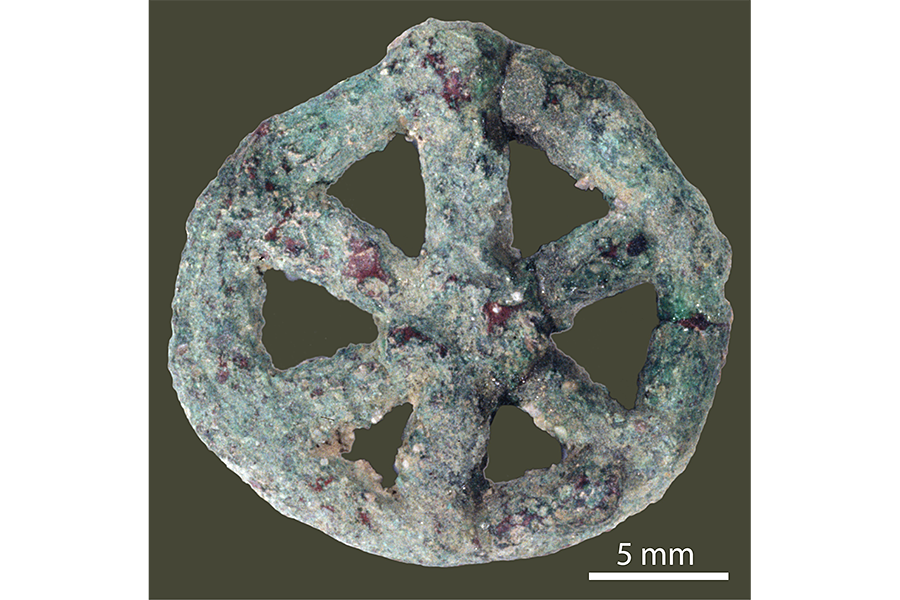Is this mysterious ancient amulet a snapshot of cultural innovation?
Loading...
What can a corroded lump of metal say about the history of manufacturing? Quite a lot, scientists suggest.
A 6,000-year-old amulet unearthed at the archaeological site of Mehrgarh in southwestern Pakistan doesn't look like anything special. It is completely corroded. But a team of scientists have unlocked its secrets by peering into the microstructure of the metal.
And it turns out, this amulet shows the earliest known evidence of a metalworking technique still in use today, according to a paper published Tuesday in the journal Nature Communications.
"Although it has been corroded, although it has been buried in the ground for thousands of years," says study lead author Mathieu Thoury of the French national Synchrotron facility and the French National Center of Scientific Research (CNRS), in an interview with The Christian Science Monitor.
It provides "a unique testimony of the civilization at the time," he adds.
The amulet was made using lost-wax casting. In this method, metalworkers first shape a model of what they want the metal object to look like out of wax or some other substance that melts easily. Then the wax model is encased in clay and the whole thing is baked. The wax melts out, leaving a cavity just the right shape. Metalworkers then pour molten metal into the cavity, cool the whole thing, and break the clay mold off from around the object.
This technique "would bring about a true revolution in metal casting history, as it allows the creation of virtually any shape," writes Marcos Martinón-Torres, a professor of archaeological science at the University College London who was not involved in the research, in an email to the Monitor.
"Before the inception of this technique, bronze casters were constrained by the need to use a mould made of several parts fitting together," he writes, "which was more limited in terms of the shapes and volumes you could create, required a lot more work, and entailed many risks of failure."
Researchers had examined the amulet a decade ago "but could not conclude what technological process had been used by the metalworkers of the time," Dr. Thoury says. In fact, this previous research yielded conflicting clues. That analysis suggested that the metal object is composed of copper.
Confusingly, structures within the metal bore the signature of a copper alloy, but the researchers found no evidence of any other element other than copper.
Thoury and his colleagues used newer technology, photoluminescence spectroscopy, to image the microstructure of the metal, recreate the history of the amulet, and resolve the confusion.
They found that as the amulet cooled, the metal solidified in stages. First pure copper crystallized in long, rod-like structures known as dendrites. Then, the rest of the molten metal solidified around them.
But here's the catch. That region around the dendrites formed as an alloy, which means another chemical element was involved, even though the scientists had not detected anything other than copper. But the imaging done by Thoury and his team revealed that it was indeed an alloy, but not with lead or another alloying metal, but with oxygen. The element must have been incorporated when the molten metal was in the air, the scientists suggest, resulting in the cuprous oxide that formed between the dendrites of pure copper within the amulet as it cooled.
"This is a great example of how increasingly sophisticated materials science research is giving these silent objects a 'voice,' to allow the artifacts to 'speak' for themselves as we try to reconstruct the ancient cultures that produced them, and better understand the invention and spread of technologies (like metallurgy) that impacted the world in complex ways," writes Robert Murowchick, director of the Boston University Asian Archaeology and Cultural Heritage Research Initiative who was not involved in the research, in an email to the Monitor.
Dr. Murowchick, Dr. Martinón-Torres, and Thoury all speculate that perhaps this amulet sits at the cusp of metalworking innovation.
Not only is this the earliest metal object known to be made by lost-wax casting, the evidence that metalworkers were working with pure copper rather than a metal alloy suggests a more primitive stage of the technology. Pure copper is more difficult to work with, with a higher melting temperature and other challenges, so metalworkers quickly discovered that combining the material with lead, arsenic, tin, or other elements would make it easier to work with, explains Murowchick.
Martinón-Torres agrees and adds that although the metalworking technique of lost-wax casting is highly advanced, the object shape is surprisingly simple. Metalworkers can make complex three-dimensional shapes such as pins, pendants, and complicated weapons using lost-wax casting. So perhaps the simple amulet was just one of the first objects created using this method while metalworkers were still figuring it out.
"The origins of lost-wax casting have long been sought, and long debated," Murowchick writes. "These very early finds of lost-wax casting from Mehrgahr add weight to the argument that perhaps South Asia is the source of this technology, if indeed a single source is a viable interpretation (it is quite possible that there were multiple 'origins' for these technologies)."
Although the amulet may look "unimpressive and uninspiring," he says, this research shows "it is part of that endless human experiment to try to recognize a problem need and devise a solution, to make use of resources available to you and to create new techniques to achieve the desired product. These earliest stages of mining, smelting, alloying, and casting from the plains of Mehrgahr and other ancient sites would leave their technological, artistic, military, political, and social mark on cultures for the next six thousand years."








